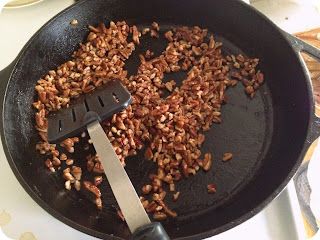
For years I've been attending a fall barn party in which everyone brings a dish to share with the wine, beer, and live music provided by the hosts. This year I decided to find a simple dish that would be cheap to make, feed many, and wouldn't be a high risk perishable. My inspiration came from a cookbook I'd recently purchased, Helen Brown's West Coast Cook Book, published in 1952. The recipe I liked was the California Potato Salad with White Wine. It seemed simple, but the addition of white wine was a charm, and the short list of ingredients was accessible. I found that white wine is in fact a great pairing for potatoes and building this salad was easy. It's one of those dishes you can make ahead of time for any event, but especially useful if you don't want to worry about keeping something hot or cold. It was a taste explosion of the best kind. Helen Brown's West Coast Cook Book was a four dollar investment which I consider to be a boon.
Helen Evans Brown and I could've been great friends in a different lifetime. She was a food writer and chef from Pasadena, California that also collected cookbooks. By the time of her death in 1964, Helen's collection included 5,000 titles on food history and cooking. The titles that withstood the test of time are now being sold off by Janet Jarvits of Cook Books. Ironically, not much is written about Helen Brown herself. James Beard was a close friend and together they wrote The Complete Book of Outdoor Cookery. It's unfortunate that Helen isn't well known since her West Coast Cook Book was actually a seminal work on Western American food culture, drawing from the food traditions of both immigrant and native populations. In 1952, the West Coast was still cultivating its culinary identity in the spirit of gaining acceptance and recognition from the East Coast establishment. That's why Helen Brown's West Coast Cook Book was so important, because it gathered without prejudice, the foodways of the entire western coast, from California to Washington state (the exception being Alaska, which hadn't yet become a state). In her introduction, Helen explains the sources for all the recipes, which resonates with me and my own attempts at collecting oral and written food histories.
"The recipes have come from many sources. Some were evolved from tantalizing and usually vague descriptions by early historians. Many came from early cook books - books which bear considerable resemblance to one another, as the good ladies of that day stole quite shamelessly from one another. As these books were invariably compiled to raise funds for some worthy cause, this larceny probably had a heavenly blessing. These recipes have been adapted for modern use. Some are recipes from old families, which I have been fortunate in obtaining, and some are for dishes now so well known that, out here, we cook them without benefit of rules, and invariably have our own versions. Then there are some fine recipes from famous eating places on the West Coast."
I'm ecstatic to have discovered Helen Brown, my soul sister from the great beyond. Helen having fronted for the West Coast, me fronting for the Middle West, both obsessive cookbook collectors who troll for recipes from anywhere and anyone. This will not be my last word on Helen because I'd also like to delve into some of her other recipes, like Chinese Almond Cakes, Hangtown Fry, and Bodega Dill Beans.
As for the white wine potato salad, it keeps nicely for up to two days, and should actually be made several hours ahead of time. I found this out since in my typical scattered approach to life, I showed up to the barn party at the right time, but on the wrong day. I was a day early and knew something was up when I pulled into the grassy field to park and heard Pour Some Sugar on Me blasting from the open barn doors. I spotted a large guy wearing a tux and a purple vest and realized I was about to crash an Iowa wedding reception with my West Coast Potato Salad. Oops. Back home I went and popped the salad back in the fridge.
Helen Brown's White Wine Potato Salad
(I've renamed this recipe to pay homage to its curator. Because I made this for a larger gathering, I doubled the recipe, but the recipe as written here, should serve 8 to 10. If you decide to make this salad, set aside a glass of the white wine to toast Helen Evans Brown.)
Boil 5 large potatoes (I used regular old Russets) until just tender. Just tender is key, because you don't want the potatoes to get too soft or they'll fall apart when you start mixing in the other ingredients, and all the marinating is going to soften them even more. After boiling, slice or dice the potatoes, and dress while warm, with 2/3 of a cup of white table wine mixed with 1/3 cup of olive oil, a tablespoon of white wine vinegar, 1/4 cup of minced green onions, 2 tablespoons of minced parsley, salt and pepper to taste, and 1/4 cup of melted butter. Let marinate for several hours before serving. Don't worry if the mixture appears soupy at first, because as it marinates, the potatoes are going to absorb the liquid. By the time you take it out to serve, the flavors will have married and heightened into something amazing. Helen also suggests that boiled, halved chestnuts mixed in make it even more interesting.
5 large potatoes
2/3 cup white wine
1/3 cup olive oil
1 Tablespoon white wine vinegar
1/4 cup minced green onions
2 Tablespoons minced parsley
Salt and pepper
1/4 cup melted butter














































